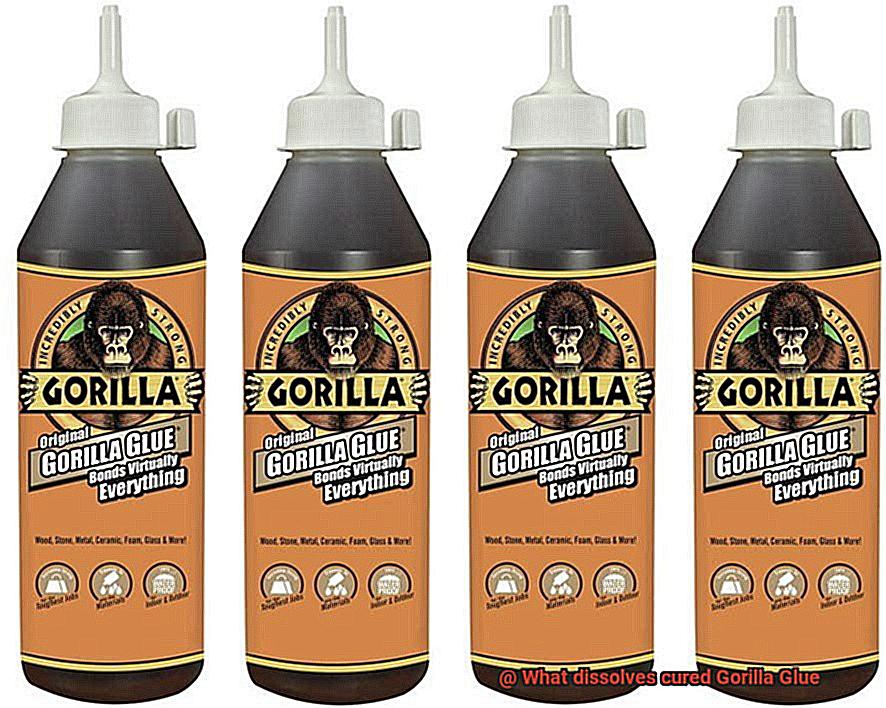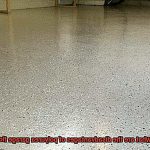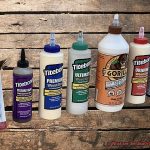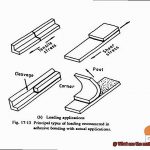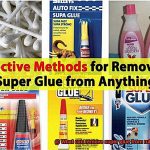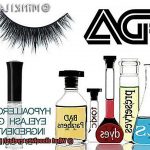Today, we’re delving into the captivating realm of adhesive solutions. Whether you’re a DIY fanatic or a seasoned craftsman, chances are you’ve come face-to-face with the mighty Gorilla Glue.
This powerhouse adhesive is renowned for its unyielding grip and endless possibilities. But what happens when you find yourself in need of an escape plan?
Fear not, my friend. We’re here to unravel the secrets of dissolving cured Gorilla Glue.
So, grab a seat and prepare yourself for a mind-bending journey through the art of dissolving wizardry.
Chemical Composition of Gorilla Glue
Contents
- 1 Chemical Composition of Gorilla Glue
- 2 Bonding Properties of Cured Gorilla Glue
- 3 Factors Influencing Dissolution of Cured Gorilla Glue
- 4 Solvents for Dissolving Cured Gorilla Glue
- 5 Other Methods for Removing Cured Gorilla Glue
- 6 Safety Precautions When Dissolving or Removing Gorilla Glue
- 7 Limitations and Considerations When Attempting to Dissolve or Remove Gorilla Glue
- 7.1 Challenges of Dissolving Gorilla Glue: Resistance to Solvents: Gorilla Glue is designed to withstand extreme conditions, including heat, moisture, and chemicals. This makes it highly durable and long-lasting but difficult to dissolve. Limited Effectiveness of Acetone: While acetone is commonly used to remove adhesives, it may only soften Gorilla Glue slightly without completely dissolving it. Impact of Different Surfaces:
- 7.2 Age Factor:
- 7.3 Alternative Removal Methods:
- 7.4 Prevention Strategies:
- 7.5 Adhering to Manufacturer Guidelines:
- 8 Conclusion
Gorilla Glue, the renowned adhesive famous for its incredible strength and versatility, owes its superior qualities to its unique chemical composition. Understanding the constituents of Gorilla Glue is paramount in comprehending what can dissolve it and what cannot.
At its core, Gorilla Glue is a polyurethane-based adhesive. This means that it contains polyurethane polymers as its primary component. Polyurethane, a type of polymer, forms a tenacious and resilient bond when it cures.
The main ingredient in Gorilla Glue is diphenylmethane diisocyanate (MDI), a type of diisocyanate. MDI is an exceedingly reactive compound that reacts with water molecules to create urea, carbon dioxide, and the coveted polyurethane bond.
In addition to MDI, Gorilla Glue also incorporates other essential elements. Polyvinyl acetate (PVA) acts as a binder, while various additives like fillers, solvents, and stabilizers enhance the adhesive properties and prolong its shelf life.
When Gorilla Glue is applied onto surfaces, it undergoes a chemical reaction known as polymerization. During this process, MDI molecules react with water molecules present in the environment or on the surfaces being bonded. As a result, a robust and inflexible polyurethane bond forms and gradually cures over time.
The cured Gorilla Glue exhibits remarkable durability due to the formation of crosslinks between the polyurethane chains. These crosslinks contribute to the glue’s exceptional strength and resistance against numerous environmental factors.
Nevertheless, while Gorilla Glue is highly resistant to most solvents once cured, there exist substances that can potentially dissolve it. Acetone, for example, has proven effective in softening and breaking down cured polyurethane. Acetone functions by dismantling the polymer chains, thereby weakening the bond and facilitating glue removal.
It is important to exercise caution when employing acetone as a means of dissolving Gorilla Glue, as it may not be suitable for all surfaces. The potent solvent can inflict damage upon certain materials such as plastics, vinyl, and painted surfaces.
Alternatively, specialized adhesive removers designed specifically for cured polyurethane adhesives like Gorilla Glue are available in the market. These removers typically consist of a blend of solvents and chemicals that target the polyurethane bond without causing harm to the treated surfaces.
Bonding Properties of Cured Gorilla Glue
The bonding properties of cured Gorilla Glue are truly remarkable. This adhesive, with its unique chemical composition containing polyurethane, undergoes a curing process when exposed to moisture. During this process, strong cross-linking bonds are formed, resulting in an incredibly tough and durable bond that is highly resistant to dissolving agents.
One of the standout features of cured Gorilla Glue is its exceptional adhesion to a wide variety of materials. Whether it’s wood, metal, glass, ceramic, or many plastics, this glue forms a strong bond that can withstand high temperatures, moisture, and even some chemicals. Its versatility makes it perfect for a myriad of applications.
However, achieving maximum bonding strength requires careful consideration of several factors. Surface preparation plays a crucial role in ensuring optimal adhesion. Additionally, temperature and curing time must be taken into account to enhance the bond’s resilience.
While Gorilla Glue’s bonding properties are impressive, there may be instances where dissolving the cured glue becomes necessary. Unfortunately, this can be quite challenging due to its resistance to many solvents commonly found in households like water, vinegar, or rubbing alcohol.
Acetone is often recommended as a solvent for dissolving cured Gorilla Glue. It effectively weakens the bond and facilitates the separation of bonded objects. However, caution must be exercised as acetone can potentially damage certain materials such as plastic or painted surfaces. It is best to conduct a small-scale test on an inconspicuous area before proceeding.
In cases where larger or stubborn bonds need to be addressed, heat can be employed to soften the cured glue. By applying heat using a hairdryer or heat gun, the bond can be weakened and separation made easier. It is essential to ensure that the materials being bonded can withstand the heat without sustaining damage.
Alternatively, mechanical methods like scraping or sanding can be utilized to remove dried or cured Gorilla Glue. However, these methods can be time-consuming and may result in surface damage.
Factors Influencing Dissolution of Cured Gorilla Glue
Gorilla Glue, renowned for its formidable strength and adaptability, may occasionally require dissolution. The factors influencing this process are multi-faceted, encompassing the type of Gorilla Glue utilized, the surface to which it adheres, and the solvent employed for dissolution.
Firstly, each variant of Gorilla Glue possesses distinct chemical compositions and characteristics, which can impact its dissolution. Original Gorilla Glue, Gorilla Super Glue, and Gorilla Wood Glue each exhibit unique properties that affect how they break down.
Secondly, the material on which the cured Gorilla Glue is bonded also plays a pivotal role in its dissolution. Surfaces differ in their resistance to solvents; plastic surfaces may prove more susceptible to certain solvents than metal or wood surfaces. To achieve efficacious dissolution, it is crucial to consider the compatibility between the solvent and the bonded surface.
Thirdly, selecting an appropriate solvent is essential when attempting to dissolve cured Gorilla Glue. The chemical properties of the solvent determine its capacity to disintegrate adhesive bonds. Acetone, isopropyl alcohol, mineral spirits, and vinegar are frequently employed solvents; however, it is vital to note that not all solvents are suitable for dissolving cured Gorilla Glue, as using an incompatible solvent may damage the bonded surface.
Moreover, the duration and temperature at which the solvent is applied can impact the dissolution process. Allowing ample time for the solvent to penetrate and interact with the adhesive can heighten its efficacy. Furthermore, increasing the solvent’s temperature can accelerate the dissolution process. Nevertheless, safety precautions must be observed when working with solvents, taking into account the heat resistance of the material involved.
Additionally, the thickness of the cured Gorilla Glue layer influences its dissolution. Thicker layers necessitate more time and a stronger solvent to effectively break down adhesive bonds. Practicing patience and allowing sufficient time for the solvent to permeate the adhesive layer is particularly important when confronting thicker applications.
Lastly, the age of the cured Gorilla Glue can impact its dissolution. Freshly cured glue may prove more challenging to dissolve compared to older glue that has been exposed to environmental factors. Older glue may have undergone some degradation, rendering it slightly easier to dissolve. However, this factor should be considered alongside the aforementioned factors when selecting an appropriate solvent and dissolution technique.
Solvents for Dissolving Cured Gorilla Glue
When it comes to dissolving cured Gorilla Glue, there are several solvents that can effectively break down its strong bond. These solvents, readily available in stores, include:
- Acetone: A powerful solvent commonly found in nail polish removers. Soak the affected area in acetone, allowing it to penetrate the glue and weaken its bond. Use a scraper or cloth to remove the softened glue. Remember, acetone is highly flammable, so exercise caution when using it.
- Isopropyl Alcohol: Also known as rubbing alcohol, this solvent can be effective in dissolving cured Gorilla Glue. Soak the affected area in isopropyl alcohol and let it penetrate the glue. Afterward, remove the softened glue with a scraper or cloth.
- Mineral Spirits: Commonly used in paint thinners, mineral spirits are effective solvents for dissolving cured Gorilla Glue. Soak the affected area in mineral spirits and then remove the softened glue with a scraper or cloth.
- Paint Thinners: Some paint thinners contain solvents designed to break down paint, making them effective for dissolving cured Gorilla Glue as well. Follow the instructions on the paint thinner bottle and test it on a small area before using it extensively.
- Vegetable Oils: Certain vegetable oils can be used to dissolve cured Gorilla Glue. Apply the oil to the glue and let it sit for some time to penetrate and weaken the bond. Then, use a scraper or cloth to remove the softened glue. Keep in mind that vegetable oils may not be as effective as other solvents and may leave an oily residue.
Other Methods for Removing Cured Gorilla Glue
Other methods for removing cured Gorilla Glue include:
- Mechanical means: This involves physically scraping or peeling off the glue using tools such as a putty knife, scraper, or even your fingernails. This method works best if the glue is not too thick or if it has started to degrade over time. However, be careful not to damage or scratch the surface you are working on.
- Soaking in water: If the surface allows for it, you can try soaking the glued area in warm water for an extended period. This can help soften the glue, making it easier to remove. You can also try adding a few drops of dish soap to the water, as this can help break down the adhesive properties of the glue.
- Freezing: For certain surfaces and materials, freezing the glued area can be effective. You can place ice packs or bags of frozen vegetables over the glue and let it sit for a while. The extreme cold can cause the glue to become brittle, making it easier to chip or peel off.
- Sanding: If all else fails and you are dealing with a stubborn layer of cured Gorilla Glue, sanding might be your last resort. Using sandpaper or a power sander (with caution), you can gradually remove the glue by wearing it down. This method requires patience and care to avoid damaging the underlying surface.
- Applying heat: Another method is to use heat to soften the glue. You can do this by applying a heat source such as a hairdryer or a heat gun to the affected area. The heat will cause the glue to become more pliable, allowing you to scrape it off with a putty knife or a similar tool. Be cautious when using heat, as excessive heat can damage the surface.
- Using solvents: Acetone or nail polish remover can help dissolve the glue and make it easier to remove. Test the solvent on an inconspicuous area first to ensure it doesn’t cause any damage or discoloration. If successful, apply the solvent to a cloth and gently rub the affected area until the glue starts to loosen.
- Natural remedies: Vinegar or lemon juice can be used to break down the adhesive properties of Gorilla Glue. Soak a cloth or sponge in vinegar or lemon juice and apply it to the cured glue. Let it sit for a while, then gently scrub or scrape away the softened glue.
- Mechanical methods: For stubborn or large areas of cured Gorilla Glue, resort to sanding or cutting. Sanding can be done using sandpaper or a power sander, but be prepared for some elbow grease and potential damage to the underlying surface. Cutting involves carefully slicing through the glue with a sharp utility knife or razor blade, requiring precision and caution to avoid injury.

Safety Precautions When Dissolving or Removing Gorilla Glue
When attempting to dissolve or remove Gorilla Glue, it is crucial to prioritize your safety and take the necessary precautions to prevent harm or accidents. Here are some key safety measures to consider:
- Wear protective gloves: Gorilla Glue can be harsh on the skin, so it is essential to wear protective gloves when working with any chemical solvents or adhesive removers. This will help prevent skin irritation or burns.
- Work in a well-ventilated area: Chemical solvents and adhesive removers often emit strong fumes that can be harmful if inhaled in high concentrations. To minimize the inhalation of fumes and ensure proper ventilation, it is recommended to work in a well-ventilated area, such as a room with open windows or doors, or even outside if possible.
- Follow manufacturer’s instructions: Different solvents and removers may have specific application methods and safety guidelines. It is crucial to read and follow the instructions provided by the manufacturer carefully. This will help ensure safe and effective use of the product.
- Keep out of reach of children and pets: Chemical solvents and adhesive removers are toxic and should be stored securely in a place where they cannot be accessed by children or animals. Ingesting these products can cause serious harm, so it is important to keep them safely stored away.
- Have a clean-up plan: Before starting the process of dissolving or removing Gorilla Glue, it is advisable to have a clean-up plan in place. This includes having appropriate containers for disposing of used solvents or removers, as well as cleaning materials such as rags or paper towels to wipe away any residue. Having a plan in place will help ensure a smooth and safe removal process.
Limitations and Considerations When Attempting to Dissolve or Remove Gorilla Glue
Gorilla Glue is renowned for its exceptional adhesive properties, making it a popular choice for various bonding applications. However, attempting to dissolve or remove cured Gorilla Glue can present several limitations and considerations.
In this essay, we will explore the challenges of dissolving Gorilla Glue, the impact of different surfaces, potential damage risks, the age factor, alternative removal methods, prevention strategies, and the importance of adhering to manufacturer guidelines.

